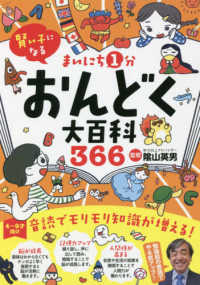- ホーム
- > 洋書
- > 英文書
- > Science / Mathematics
基本説明
A highly successful textbook, provides students with a complete overview of the principles, theories and key applications of modern mass spectrometry. Updates include: An increased coverage of MALDI and ESI, a more detailed description of time of flight spectrometers, new material on isotope ratio mass spectrometry, and an expanded range of applications.
Full Description
The latest edition of a highly successful textbook, Mass Spectrometry, Third Edition provides students with a complete overview of the principles, theories and key applications of modern mass spectrometry. All instrumental aspects of mass spectrometry are clearly and concisely described: sources, analysers and detectors. Tandem mass spectrometry is introduced early on and then developed in more detail in a later chapter. Emphasis is placed throughout the text on optimal utilisation conditions. Various fragmentation patterns are described together with analytical information that derives from the mass spectra. This new edition has been thoroughly revised and updated and has been redesigned to give the book a more contemporary look. As with previous editions it contains numerous examples, references and a series of exercises of increasing difficulty to encourage student understanding. Updates include: Increased coverage of MALDI and ESI, more detailed description of time of flight spectrometers, new material on isotope ratio mass spectrometry, and an expanded range of applications.
Mass Spectrometry, Third Edition is an invaluable resource for all undergraduate and postgraduate students using this technique in departments of chemistry, biochemistry, medicine, pharmacology, agriculture, material science and food science. It is also of interest for researchers looking for an overview of the latest techniques and developments.
Contents
Preface xi
Introduction 1
Principles 1
Diagram of a Mass Spectrometer 4
History 5
Ion Free Path 10
1 Ion Sources 15
1.1 Electron Ionization 15
1.2 Chemical Ionization 17
1.3 Field Ionization 28
1.4 Fast Atom Bombardment and Liquid Secondary Ion Mass Spectrometry 29
1.5 Field Desorption 31
1.6 Plasma Desorption 32
1.7 Laser Desorption 33
1.8 Matrix-Assisted Laser Desorption Ionization 33
1.9 Thermospray 41
1.10 Atmospheric Pressure Ionization 42
1.11 Electrospray 43
1.12 Atmospheric Pressure Chemical Ionization 55
1.13 Atmospheric Pressure Photoionization 56
1.14 Atmospheric Pressure Secondary Ion Mass Spectrometry 61
1.15 Inorganic Ionization Sources 65
1.16 Gas-Phase Ion-Molecule Reactions 72
1.17 Formation and Fragmentation of Ions: Basic Rules 76
2 Mass Analysers 85
2.1 Quadrupole Analysers 88
2.2 Ion Trap Analysers 100
2.3 The Electrostatic Trap or 'Orbitrap' 122
2.4 Time-of-Flight Analysers 126
2.5 Magnetic and Electromagnetic Analysers 143
2.6 Ion Cyclotron Resonance and Fourier Transform Mass Spectrometry 157
2.7 Hybrid Instruments 164
3 Detectors and Computers 175
3.1 Detectors 175
3.2 Computers 182
4 Tandem Mass Spectrometry 189
4.1 Tandem Mass Spectrometry in Space or in Time 189
4.2 Tandem Mass Spectrometry Scan Modes 192
4.3 Collision-Activated Decomposition or Collision-Induced Dissociation 195
4.4 Other Methods of Ion Activation 199
4.5 Reactions Studied in MS/MS 202
4.6 Tandem Mass Spectrometry Applications 204
5 Mass Spectrometry/Chromatography Coupling 217
5.1 Elution Chromatography Coupling Techniques 218
5.2 Chromatography Data Acquisition Modes 228
5.3 Data Recording and Treatment 230
6 Analytical Information 243
6.1 Mass Spectrometry Spectral Collections 243
6.2 High Resolution 245
6.4 Low-mass Fragments and Lost Neutrals 257
6.5 Number of Rings or Unsaturations 258
6.6 Mass and Electron Parities, Closed-shell Ions and Open-shell Ions 259
6.7 Quantitative Data 260
7 Fragmentation Reactions 273
7.1 Electron Ionization and Fragmentation Rates 273
7.2 Quasi-Equilibrium and RRKM Theory 275
7.3 Ionization and Appearance Energies 279
7.4 Fragmentation Reactions of Positive Ions 280
7.5 Fragmentation Reactions of Negative Ions 291
7.6 Charge Remote Fragmentation 293
7.7 Spectrum Interpretation 294
8 Analysis of Biomolecules 305
8.1 Biomolecules and Mass Spectrometry 305
8.2 Proteins and Peptides 306
8.3 Oligonucleotides 342
8.4 Oligosaccharides 357
8.5 Lipids 371
8.6 Metabolomics 386
9 Exercises 403
Questions 403
Answers 415
Appendices 437
1 Nomenclature 437
2 Acronyms and abbreviations 442
3 Fundamental Physical Constants 446
5 Isotopic Abundances (in %) for Various Elemental Compositions CHON 457
6 Gas-Phase Ion Thermochemical Data of Molecules 467
7 Gas-Phase Ion Thermochemical Data of Radicals 469
8 Literature on Mass Spectrometry 470
9 Mass Spectrometry on Internet 476
Index 479






